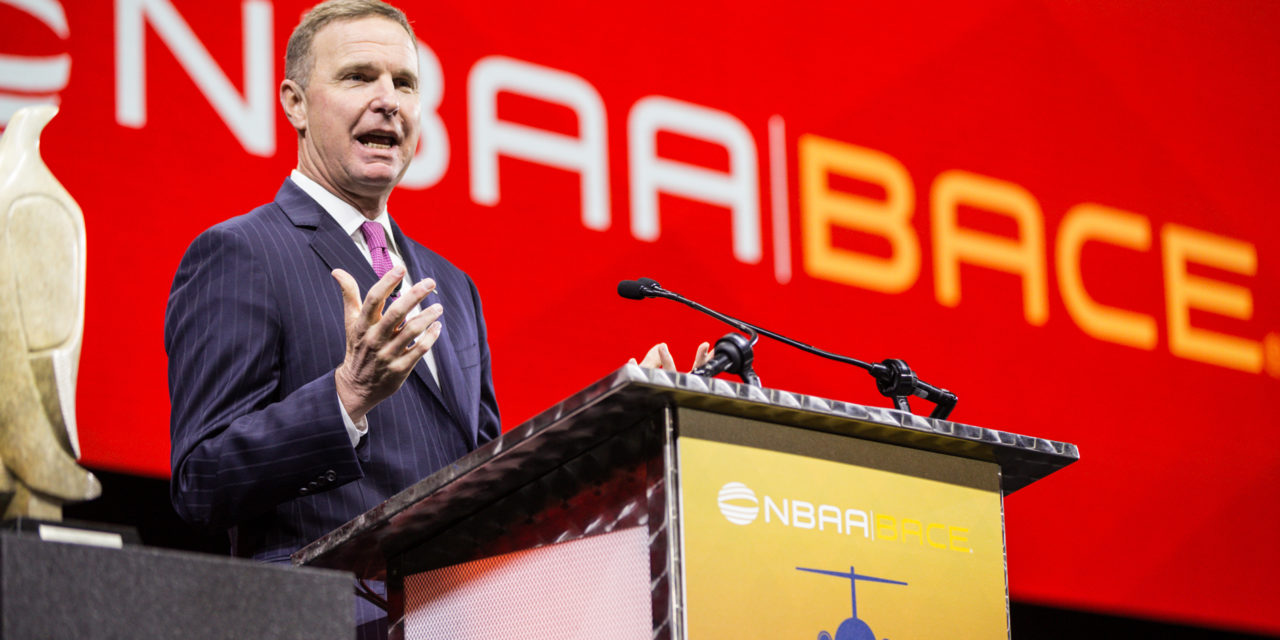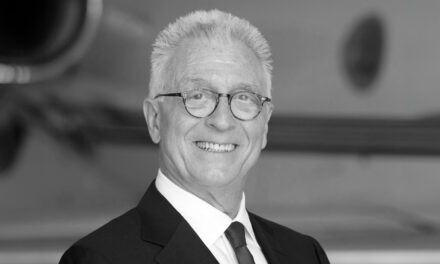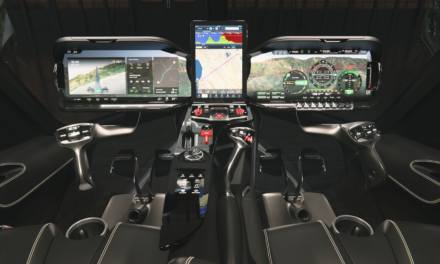A wind of positivism blew throughout the National Business Aviation Association convention held October 16-18 in Orlando, Florida. In addition to the announcement of the launch of new models during the event, the event was, once again, expected by worldwide professionals from around the world who attended the convention in large numbers for the occasion.
With a static display of more than 100 aircraft and a show with more than 1,000 exhibitors in the convention center, this new edition was especially the occasion for NBAA leaders, Ed Bolen, president and CEO of the NBAA, to highlight a recovery of activity “having exceeded even the highest of expectations,” of the actors present. For Ed Bolen, “the convention has shown that this has been one of THE places to attend for business aviation for decades,” and added that the 2018 edition will have allowed them to “focus on the people, technologies and leadership qualities that will maximize today’s actions, while keeping an eye on the investments and innovation that will ensure the future of the industry.”.
For many business aviation professionals, especially for manufacturers, the future of the market, particularly the second hand market, Is still weak despite signs of tangible recovery.
According to JetNet, a US company specialized in the analysis and statistics of the business aviation market, in the first half of 2018, the worldwide fleet of used aircraft in operation represents 9.1% for the jets and 6.6% for the turboprops, against 10.8% and 7.6% in 2017, respectively. Their lowest level since 1998. A total of 1,334 transactions were made for the jet segment in the first six months of 2018 and 651 for the turboprop sector.
Nevertheless, these are average numbers and for some manufacturers the second hand market remains satisfactory. This was confirmed during the show by Eric Trappier, CEO of Dassault Aviation, who explained: “The segment of used aircraft, a traditional sign of market recovery, is doing well. An example is our Falcon 7X. By the end of 2016, there were more than 30 used 7X on the market. Since then, this inventory has decreased by 50%. And a large number of second-hand Falcons have found buyers in China and other Asian countries, where operators had previously shown little interest in second-hand aircraft.”
Embraer launches the Praetor family
As a surprise, 48 hours before the official opening of the convention, Embraer, unveiled two new aircraft in the midsize and super-midsize segment, the Praetor 500 and 600. These two aircraft, and more particularly the Praetor 600, come not only to fill the super-midsize segment which is still lacking in the Brazilian aircraft manufacturer’s range, but above all, to strengthen and complete the Legacy 450 and 500 range whose more than one hundred units have been sold to date and from which they are directly derived. While the two jets seem at first sight externally similar to their predecessors, Embraer has made some major changes to give the new models greater autonomy. The aircraft manufacturer has simply adopted a concept that has been particularly successful when developing the Legacy 650 starting from the 600 version. Logically, Embraer first asked to Honeywell to review the performance of the HTF7500E engine. More powerful by 500 lb, this new version of the engine also gains in terms of consumption.
The addition of central and wing fuel tanks and the integration of new larger winglets – an outwardly distinctive sign between the Legacy and Praetor range – boost the performance of the original jets. More fuel capacity and more efficient engine give the Praetor 500 a range of 3,250 nm – 6,019 km (against 2,904 nm for the Legacy 450) allowing it to connect Europe to the east coast of the United States with a stopover. On its side, the Praetor 600 is announced with a range of 3,900 nm (7,220 km) that is to say 760 nm more than the Legacy 500 range. With such performances, the Praetor 600 opens the way for direct transatlantic flights from London to New York. Both aircraft have been developed to compete directly with the Cessna Latitude (Praetor 500) and the current Gulfstream G280 and Bombardier Challenger 350 in the super-midsize segment with the Praetor 600. But with the latter, the Brazilian aircraft manufacturer is especially trying to take some market share from its main competitor Textron Aviation and its Citation Longitude whose entry into service is expected within a few months. In addition to performance, the Praetor 500 and 600 benefit from a new interior design called Bossa Nova Edition. A design “inspired by our Brazilian heritage, and that will delight Praetor customers with its elegant and distinctive ambience,” said Jay Beever, Vice President of Interior Design for Embraer Executive Jets. The layout, in addition to a new design, will be equipped as standard with Honeywell’s Ovation Select cabin control system as well as 16 Mbp Ka-band internet connectivity and Gogo’s Avance L5 voice connection system.
After having been the first aircraft manufacturer to offer electronic flight control devices in the super light and midsize segments with the Legacy 450 and 500, Embraer has once again relapsed into the super midsize segment with the Praetor 600. With the announcement of these new aircraft, the Brazilian also surprised the sector on the progress of the program. Like other manufacturers in recent years, the unveiling of the new models was accompanied simultaneously by a presentation of a prototype of the two aircraft (???) in Orlando. According to the manufacturer, the first Praetor 600 flew for the first time discreetly on March 31, 2018 from its Gaviao Pexioto facility (Brazil). Still from this site, the Praetor 500 would have taken the air on September 13, 2018, just one month before the opening of the NBAA convention. At the time of the show, the program had already recorded 380 hours of flight tests (300 hours for the 600 and 80 for the 500) spread over a total of four prototypes.
Embraer has allocated three aircraft for the development of the Praetor 600 – including a pre-series aircraft – and one prototype for the Praetor 500. In addition to undeniable industrial interest and optimization of development costs, the recovery of Legacy 450 and 600 modules must allow the Brazilian manufacturer to save time on the certification program, especially to face the arrival of new competitors. For the Praetor 600, Embraer plans an entry into service in the second quarter of 2019 and before the end of 2019 for the Praetor 500. With a competitive list price of $ 17 million for the Praetor 500 and $ 21 million for the 600, Embraer is trying to establish itself quickly with these two aircraft in respective particularly active market segments.
Textron Aviation and the Netjets gamble
Textron Aviation made a particularly strategic announcement dealing with a major order from the fractional ownership operator NetJets. This announcement is nonetheless in doubt since it is actually a “conclusion agreement for a purchase option” of a total of 325 Citation. Netjets, which has operated more than 500 Citations since 1984, has opted for the acquisition of 175 Cessna Citation Longitude but above all 150 Cessna Citation Hemisphere becoming thus the launch customer of the aircraft. For Netjets Chief Executive Officer Adam Johnson, “The acquisition of these new aircraft has allowed us to rethink the first order we placed for the Citation Latitude in 2015 which included the acquisition of 175 aircraft. We have just placed an order for our 100th Latitude. It will be the same for the Longitude and Hemisphere.” The operator should be the “savior” not only of the aircraft, but also of the Safran’s Silvercrest engine.
The latter, whose repeated delays in its development led to the abandonment of Dassault’s Falcon 5X, had at the same time led Textron Aviation to delay he Hemisphere program. Despite the turbulence encountered, Brad Thress, Textron Aviation’s Vice President of Engineering, said: “we have worked tirelessly with Safran to understand the development stages of the Silvercrest engine. Throughout these steps, we have remained confident that this engine is the best choice for the Hemisphere and we are pleased to see Safran’s long-term commitment to deliver it on time and on schedule.” As the launch customer, Netjets is working closely with Textron Aviation to customize the aircraft for its specific needs. Regarding the delivery of this order, the operator and Textron Aviation confirm that the first aircraft, a Citation Longitude model, will start operations in the second half of 2019, as soon as the certification of the aircraft will be obtained.
Bombardier is thinking Global
The NBAA convention was an opportunity for the Canadian manufacturer to highlight its future Global range including the Global 7500 whose US certification by the FAA – Federal Aviation Administration – and commissioning were scheduled for November 2018. Bombardier also gave information about its two other Global programs, the 5500 and 6500, both derived respectively from the Global 5000 and 6000. As a reminder, last May, the aircraft manufacturer had taken advantage of the European Business Aviation Exhibition (EBACE) to unveil the expansion of its Global range with these two long-haul business jets, both equipped with a new wing and powered by the new Rolls-Royce Pearl engine. The latter, more powerful, especially on high altitude terrain and in hot regions, also consumes 7% less kerosene than the earlier BR710 installed on previous Global. This new configuration allows the Global 5500 to fly 5 700nm (10,600 km) with 16 passengers on board and 6,600 nm (12,200 km) for the Global 6500 with 17 passengers in the cabin.
In addition to performance, Bombardier also re-examined avionics by integrating into the “Vision” cockpit the improved vision system combining infra-red images and computer-generated images. In the cabin, the two Global will be equipped with the new “Nuage” seat specially developed for this range of aircraft as well as a broadband internet connection and a 4K video system. Regarding the program progress of these “new aircraft”, Bombardier has indicated that the program was on time with 70% of the scheduled flight tests already completed. The aircraft manufacturer has also indicated that it has validated the aerodynamics of the wing whose profile has been revised to improve the speed and autonomy performance of the jets. David Coleal, President of Bombardier Business Aircraft, said, “The welcome given to the Global 5500 and Global 6500 aircraft has been extraordinarily positive since their unveiling at EBACE, which has allowed us to maintain the timelines of the program.”.
Falcon 6X program on track
Officially launched in February 2018, the Falcon 6X program successfully follows the aircraft manufacturer’s schedule. This was confirmed by Eric Trappier, CEO of Dassault Aviation. During a press conference, he has indicated that “the 6X was currently entering the detailed design phase. The production of the first components has also started and the key partnership agreements have been put in place.” According to the CEO, “the PW812D certification campaign is also progressing satisfactorily“, with several engines already in flight and bench test. The manufacture of the rear fuselage began during the summer and the production of the central part of the latter would soon follow according to the Saint-Cloud aircraft manufacturer. The nacelle design activities (inlet, blower hoods, thrust reverser and engine accumulation system), provided by UTC Aerospace Systems, a new Dassault Aviation partner, are also underway. “The development schedule is exceptionally tight for this kind of program,” said Trappier, before adding that “there was however a good level of maturity in the design of the aircraft and components which allows us to be very confident for a first flight in 2021“.
Dassault Aviation has also indicated that it will deliver the first aircraft in 2022. In addition to the Falcon 6X program, Eric Trappier also looked at the future of the Falcon range during his statement, stating that “Dassault is actively preparing the future family of Falcon with a new program mentioned a few months ago and that will come a few years after the 6X. Initial development is progressing well and is currently focused on selecting key technologies for the aircraft and systems. Next year, I may be able to tell you more about this program, which is a very important long-term investment for our company.” If the Falcon 6X and the future program mobilizes the bulk of the Dassault Falcon forces, the aircraft manufacturer is nonetheless active on the improvement of aircraft currently in service and especially on the security aspect of flights, including its FalconEye. With this system which recently received FAA / EASA approval allowing pilots can descend down to 100 feet above the runway altitude before going into natural vision to complete the landing. According to Dassault Aviation, the system is expected to be approved within two years on the 8X for use in dual HUD configuration and will support EVFS (enhanced flight vision system) on landing, allowing pilots to complete full approach and landing without using natural vision to see the runway. The builder says it is confident of a certification for the landing by EVFS by the end of 2020 on its Falcon 8X.
Gulfstream concentrates on the G600
Present with its entire range on the static display, Gulfstream gave precisions front of the press about the progress of the G500 / G600 program. The G500 received FAA certification in July 2018 and first deliveries of the latter have started on September 27, 2018. The aircraft manufacturer said it is now working hard to complete the G600 program whose deliveries should begin in early 2019. Rather enthusiastic, Gulfstream unveiled during the event that the performance of the jet had been revised upwards after 2,600 hours of flight tests. The G600 has now 14% more autonomy than the initial expected figures. The aircraft, which had been announced with a range of 4,800 nm (8,890 km), will now be able to travel 5,500 nm (10,190 km) at a Mach 0.90 speed. Direct flights from London to Los Angeles or from Vienna to Hong Kong will now be possible.
Nevertheless, the aircraft manufacturer has indicated that, in long-haul configuration at a speed of Mach 0.85, the G600 will have a range of 6 500 nm (12 038 km). If the manufacturer of Savannah Even particularly busy with the implementation of these aircraft, the manufacturer has not forgotten about the future. Several sources indicate that Gulfstream is preparing to face the Bombardier Global 7500 Bombardier with a new aircraft, larger and with greater autonomy than the G650ER. The latter, unofficially named G750 would be based on the technical characteristics of the G600. In addition to the high-end segment, Gulfstream could also unveil a model to fill the lack of new generation aircraft between the G280 and G500.
The Aerion is taking shape
Despite the doubts of the beginning, the program of the supersonic AS2 is gradually taking shape thanks in particular to the evolution of the various partners of the program which today includes in its ranks Lockheed Martin, GE Aviation and Honeywell. At the Aerion Corporation press conference, GE Aviation announced that it had completed the initial design of the first supersonic engine specifically designed for the aircraft. This new class of engines, unveiled under the name of Affinity, is, according to the engine manufacturer, “a new class of engines with average dilution ratio allowing “exceptional” performances for supersonic and subsonic flights”. On the technology side, GE’s Affinity is described as a twin-blast, two-blower turbofan engine controlled by a new-generation Full Authority Digital Engine Control (FADEC) system.
During the announcement, GE also states that its engine, deliberately designed to meet the stringent phase 5 subsonic noise requirements, will also surpass current emission standards. Parallel to the engine, Aerion and Honeywell Aerospace announced their collaboration in the development of a new cabin and a new cockpit control system for the AS2 developed around the Primus Epic system. For Tom Vice, President and CEO of Aerion, “The aim of a first AS2 flight in 2023 is still relevant. We even hope to have a first supersonic flight before the end of this same year“.
Pilatus continues to climb the business jet market with PC-24
Since the type certification of its PC-24 Super Versatile in December 2017, Pilatus has reported delivering a total of twelve aircraft in the United States, Switzerland, Luxembourg and Southern Africa. By the end of the year, the company plans 23 PC-24s in service with its customers. According to the Stans aircraft manufacturer, the fleet of PC-24 has accumulated since its entry into service 1,200 hours of flight, including 620 hours only for the first serial PC-24 delivered in February 2018 to PlaneSense, a US condominium company. While planning to deliver 40 aircraft in 2019 and 84 from 2020, Pilatus continues to perform post-certification tests on several elements to increase the operational capabilities of the PC-24. These tests include the steep approach, cabin layout for Evasan missions and operation on unpaved runways. The Swiss manufacturer says it has carried out more than 150 take-offs and landings from dirt, grass and gravel on platforms in Switzerland, Canada, Italy and the United Kingdom. Pilatus expects to receive certification for operation from these surfaces by the end of this year.
Boeing Business Jet presents a new interior
At the show, Boeing Business Jets (BBJ) announced the delivery of the first BBJ MAX aircraft to a customer. The aircraft, delivered in “bare hull” configuration, will receive its interior accomodation in an outfitting center chosen by the client. To commemorate this first shipment, Boeing Business Jets unveiled a new interior concept designed by SkyStyle company. Named Genesis by SkyStyle co-founders Max Pardo and Lucas Colombo, this concept represents the company’s debut in BBJ MAX design. For these designers, “Genesis is inspired by the tranquility of nature, its bulky clouds hanging over a white sandy beach, its gentle rolling hills and its starry sky.”
Comlux realizes a new interior on BBJ and celebrates its first year of operation on the 777
Lots of news for the Zurich-based company. Comlux took advantage of the NBAA convention to take stock of its activities, starting with that of its subsidiary Comlux Completion based in Indianapolis. The latter has indeed achieved its 11th interior completion on a BBJ for a private client based in the Far East. Comlux reports that the cabin layout has a spacious executive compartment at the front, with four sets of tables and a dining / conference room with a massive table and six seats in the center section. Decorated with a ceiling dome, the owner suite at the back of the unit includes a bedroom and a private spa-style shower room. The operator emphasizes that the entire aircraft is imbued with “an Asian-inspired atmosphere with a consistent blend of contrasting color palettes achieved through the use of soft white leather, mahogany veneer, taupe carpet and golden textured fabrics“.
In addition to this announcement, Comlux also went back to its “charter” activity by celebrating the first anniversary of the operation and rental of the Crystal AirCruises “Crystal Skye” B777-200LR VIP. The aircraft, which entered service under the AOC of Comlux Aruba in August 2017, was chartered on behalf of Crystal AirCruises by OneAbove, the charter division of Comlux. During its first year of operation he “Crystal Skye” has logged more than 589 flight hours around the globe, landed in more than 35 cities and visited every continent, except Antarctica.
By Frédéric Vergnères
©NBAA









